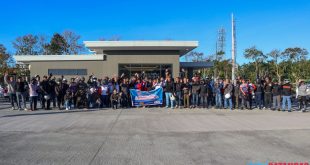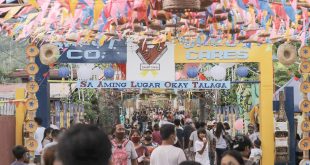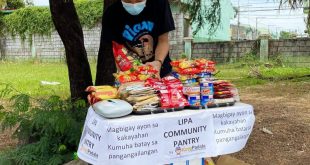Visit the Cuenca, Batangas page for all information on Cuenca.
What you are about to read is the history of Cuenca, Batangas taken from the Tourism Office of Cuenca, Batangas:
The mother town of San Jose was Bauan. Before the barrios of Bungahan, Labak, Dita, Dalipit and Makulot were included in the jurisdiction of San Jose . San Jose could be reached by walking a long way in the forests and fields. Being the mother town, activities such as baptism, confirmation, wedding, burying the dead and paying taxes were done there.
The Catholic Church was instrumental in opening the minds of the people. Those who were assigned Cabeza de Barangay understood the hardships and sufferings of the inhabitants. In 1875 the civic-minded leaders petitioned Gov. Paez of Batangas to make Maculot and other barrios a town. They were Don Juan Laqui, Kapitan Emeterio Laqui, Don Briccio Laqui , Kapitan Celedonio Chavez, Juez Anastacio Chavez, Cabeza Ceferino Carandang, Kapitan Pablo Matibag, Kapitan Basilio Loria and Juez Francisco Loria.
By virtue of the Highest Law of the Land Cuenca became a town on November 7, 1876. Governor Paez named it Cuenca after his hometown in Spain, resembling its climate and green scenery. This town boasts of its natural, historic and cultural attractions.
The revolution of 1896 broke out, and the able-bodied men of Cuenca, headed by Col. Briccio Laqui left their homes and joined the uprising, many of whom were not able to come back home. Foremost among whose who were at the forefront was Briccio Pantas who served as Secretary of Justice in the war cabinet of the Katipunan Supremo, Andres Bonifacio in August 1896.
St. Isidore Parish Church in Cuenca was established in 1979. A parochial school was housed at the church convent where children learned “Katon” and “cathechesis”. They were taught reading, writing and arithmetic. There was peace and the people were contented in farming, fishing and raising pigs and chicken.
It was also in 1902 when a public school was opened for Grade 1 pupils. Education then was compulsory. Aside from Education, Roads and Water System were also given importance.
With the coming of the new masters and the establishment of civil authority, a marked change was felt. Greater emphasis was given to education which became compulsory. A permanent primary school was established, followed by an intermediate school several years later. Old roads were widened and improved, and new ones were constructed. A public market was built and a water system was installed. In the meantime, the municipal government still had no house of its own, and squatted in whichever part of the town the incumbent Capitan happened to have his home as the seat of the government.
Of a primary agricultural economy as most municipalities were, farming and fishing were the principal means of livelihood of the people. Some engaged in poultry-raising and in a few limited cottage industries, but these were mainly for family consumption.
In the 1920’s , civic consciousness, fired by the clamoring desire for national independence that filled the heart of the entire country, stirred once more in Cuenca. Civic organizations came to being, the best known of which was the “KAPISANANG DIWA NG MAHIRAP” which left traces of its dynamist in the form of a piece of land which it bought and donated to the municipality for use as Municipal Cemetery. It also erected a monument in honor of Dr. Jose Rizal on the town plaza right in front of the municipal health center. (President of Kapisanang Diwa ng Mahirap was Mr. Casiano L. Endaya).
Politics, too, had its heyday in this town at that time. Two rival factions – “Ilaya” and”Ibaba” bitterly contested the presidency, and later, during the Commonwealth era, the leadership of the municipality every election. Up to pre-martial law days, this rivalry existed, although not of the same marked degree. Notable among those who held the reigns of the municipal government were Francisco Loria, Geonimo Briones, Gabriel Remo, Agustin Jardin Hoseña and Jose Laqui. During the incumbency of Mayor Laqui, World War II broke out.
By the time after the war, a few from the affluent families had attended college and become professionals. Prominent among them were Former Court of Appeals Justice Rafael B. Amparo, a former Deputy Auditor General Eugeniano P. Larosa, former GSIS Medical Director Dr. Ananias L. Chavez, former City Court Judges Eulalio Chavez and after retiring ,Victoriano Hoseña Endaya was requested by Senator Maria Kalaw Katigbak to take his place and erstwhile District Superintendent Antonio Javier. This was not an exhaustive nor a complete enumeration. Maria Umali, better known as Maestrang Maria, was the pioneer Katon teacher at the time and many professionals now acknowledge with gratefulness her tutelage which was characterized by strict adherence to the rules of discipline.
In other fields of endeavor, like the arts, literature and journalism, some Cuenqueños were also making a name for themselves, notable among whom were Antonio Jusay, in the field of painting and art work and Apolonio Loria Laqui whose poems some of which were prize-winners, short stories and articles were published by nationally-circulated Tagalog Magazines (They are kept by his son, Judge Hilario Laqui).
The coming of the Japanese occupation forces put everything to a standstill. What mattered most was food and how to get it. Whatever plans there were for the improvement of the town had to be shelved. Before the barbaric army was driven out , it had taken its toll in civilian lives murderously snuffed out, and in property razed to the ground. Half of the poblacion, including its land-marks were destroyed: the church, the building housing the municipal government, the Cuenca Elementary School Building , the barrio school buildings and most of the newly constructed residences of the more progressive families.
At this time, Mt. Maculot again gained prominence. The mountain had been acknowledged to have played the role of a shield that insured the safety of the lives and properties of the inhabitants of Cuenca on more than one occasion when Taal Volcano gave vent to thunderous and terrific explosions, killing people and animals in surrounding areas by the thousands, in the January, 1911 eruption.
Mt. Maculot earned the sobriquet “Million Dollar Hill” during world War II, because of the tons of bombs and artillery shells poured into it by American forces in an attempt to flush out the Japanese diehards hiding in the man-made caves that hone-combed its slopes. It took much more than that, however, to end the actual though sporadic fighting in Cuenca.
Makulot had been the sole source of water supply for the residents of the poblacion. With the growth of the population and the conversion of the areas to “kaingin”, the water supply had become inadequate especially during summer.
Liberation came with its numerous problems for those who survived the holocaust. On April 1, 1945, Atty. Eulalio Chavez was appointed mayor by the military authorities. One month after, Atty. Eugeniano P. Larosa was appointed in place of Atty. Eulalio Chavez. With the cooperation of Col. Pedro Pasia, whose guerillas guarded the town against the Japanese who time and again made lighting sorties from their mountain hideouts, the town, with the help of the National Government, nursed its war-inflicted wounds and took the first painful step towards rehabilitation.
“Barung-barongs” were constructed to house the municipal government and the elementary schools. Medicines and goods were procured for the sick, and the hungry inhabitants. Many qualified and able-bodied Cuenqueños found employment at the US Army Base at Batangas, thereby enabling the early economic recovery of the town .
Gradually, the town inched its way to normalcy.
The elementary school building was rebuilt and enlarged, barrio schools were repaired and new ones constructed. Roads were improved and new ones opened. Artesian wells were drilled.
In 1962, on the 85th anniversary of the municipality, the building before this existing municipal hall was inaugurated. The lot was donated by the family of Atty. Cornelio M. Aguila(proof is the Tablet at the foot of Dr. Jose Rizal’s monument) The building was financed by then Congressman Numeriano U. Babao and contributions were given by the people of Cuenca.
Because of his role in the war, Mayor Pedro Pasia served for four terms, from 1947 – 1963. His incumbency witnesses the electrification of the poblacion and some barrios, the construction of the Puericulture Center (at Rizal Park then). Home Economics and Industrial Arts Buildings, public market and barrio schools.
In the local elections of 1963, Mauricio Marasigan won the Mayoralty, the unfinished projects of the previous administration were continued and the town plaza was paved. He started the concreting of pathways to Lumampao, Don Juan. Taal Volcano erupted in 1965. President Diosdado Macapagal gave funds for the evacuees and a resettlement area was built in Poblacion I for the victims of Taal Volcano eruption from Agoncillo.
In 1967 Geronimo Cuevas won. His administration has made possible the construction of many kilometers of feeder roads, foremost among which are the Poblacion –Don Juan road and the Poblacion-Ibayiw road. These were implemented under President Marcos to stimulate economic growth in the rural and agricultural areas by providing them with the means of bringing their produce to the urban centers and in turn render the more remote regions amenable to the influence of social and cultural progress. The Leviste-type building was erected, the Artificial Breeding Center was established. The pathways to Don Juan were finished.
However, Mayor Cuevas shared the credit for whatever accomplishments his administration had with the ever-cooperative and patient people of Cuenca, both living in the town and elsewhere, and with his sister, Dircetor Lucina C. Alday whose invaluable help in having his projects attended to and supported by the directors and heads of the different bureaus of the national government he earnestly acknowledged.
In 1980 Dr. Virgilio C. Remo became the Mayor. The Cuenca Rural Waterworks and Sanitation Association was established, Martin Marasigan Memorial Hospital was built in his time. Dr. Pedro Paterno Housing Project started in his time, TD’s were given during the time of Mayor Jovino M. La Rosa and titles were given during the administration of Mayor Celerino A. Endaya. Sustainable development continued.
Of course , financial problem still exists. But , if the people of Cuenca would pay their taxes in due time , if the municipal employees would continue to do their responsibilities, and if investors would come, public private partnership would continue.
Cuenqueños let us unite, act and have people power for the SUSTAINABLE DEVELOPMENT of our CUENCA, for we are blessed to have Mt. Maculot and Taal Lake and rich human resources.
Last Updated: November 15, 2013
 WOWBatangas.com Your Source of Great News and Stories from the Province of Batangas, Philippines
WOWBatangas.com Your Source of Great News and Stories from the Province of Batangas, Philippines



